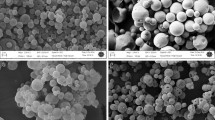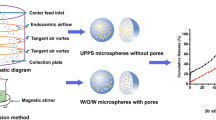Abstract
Purpose. To prepare a heterogeneously structured composite based on poly (lactic-co-glycolic acid) (PLGA) microspheres and poly(vinyl alcohol) (PVA) hydrogel nanoparticles for long-term protein drug delivery.
Methods. A heterogeneously structured composite in the form of PLGA microspheres containing PVA nanoparticles was prepared and named as PLGA-PVA composite microspheres. A model protein drug, bovine serum albumin (BSA), was encapsulated in the PVA nanoparticles first. The BSA-containing PVA nanoparticles was then loaded in the PLGA microspheres by using a phase separation method. The protein-containing PLGA-PVA composite microspheres were characterized with regard to morphology, size and size distribution, BSA loading efficiency, in vitroBSA release, and BSA stability.
Results. The protein-containing PLGA-PVA composite microspheres possessed spherical shape and nonporous surface. The PLGA-PVA composite microspheres had normal or Gaussian size distribution. The particle size ranged from 71.5 μm to 282.7 μm. The average diameter of the composite microspheres was 180 μm. The PLGA-PVA composite microspheres could release the protein (BSA) for two months. The protein stability study showed that BSA was protected during the composite microsphere preparation and stabilized inside the PLGA-PVA composite microspheres.
Conclusions. The protein-containing PLGA-PVA composite may be suitable for long-term protein drug delivery.
Similar content being viewed by others
REFERENCES
X. S. Wu. Preparation, characterization, and drug delivery applications of microspheres based on biodegradable lactic/glycolic acid polymers. In D. L. Wise, D. J. Trantolo, D. E. Altobeli, M. J. Yaszemski, J. D. Gresser, and E. R. Schwartz (eds.), Encyclopedic Handbook of Biomaterials and Bioengineering, Part A: Materials, Vol. II., Dekker, New York, 1995, pp. 1151-1152.
R. Jalil and J. R. Nixon. Biodegradable poly(lactic acid) and poly (lactide-co-glycolide) microcapsules: problems associated with preparative techniques and release properties. J. Microencapsulation 7:297-325 (1990).
S. Cohen, T. Yoshioka, M. Lucarelli, L. H. Hwang, and R. Langer. Controlled delivery systems for proteins based on poly(lactic/glycolic acid) microspheres. Pharm. Res. 8:713-720 (1991).
Y. Ogawa, M. Yamamoto, H. Okada, T. Yashiki, and T. A. Shimamoto. New technique to efficiently entrap leuprolide acetate into microcapsules of polylactic acid or copoly(lactic/glycolic) acid. Chem. Pharm. Bull. 36:1095-1103 (1988).
H. Okada and Y. Ogawa. Prolonged release microcapsule. U.S. patent 5,476,663 (1995).
H. Okada, Y. Inoue, and Y. Ogawa. Prolonged release microcapsules. U.S. patent 5,480,656 (1996).
W. Lu and T. G. Park. Protein release from poly(lactic-co-glycolic acid) microspheres: Protein stability problems. PDA J. Pharm. Sci. Tech. 49:13-19 (1995).
T. Uchida, A. Yagi, Y. Oda, Y. Dakada, and S. Goto. Instability of bovine insulin in poly(lactide-co-glycolide) (PLGA) microspheres. Chem. Pharm. Bull. 44:235-236 (1996).
K. J. Zhu, X. Lin, and S. Yang. Preparation and properties of D,L-lactide and ethylene oxide copolymer: A modifying biodegradable polymeric material. J. Polym. Sci.: Part C: Polymer Letters. 24:331-337 (1986).
D. Cohn, H. Younes, and G. Marom. Amorphous and crystalline morphologies in glycolic acid and lactic acid polymers. Polymer. 28:18-22 (1987).
H. M. Dollinger and S. P. Sawan. Bicontinuous controlled-release matrices composed of poly(d,1-lactic acid) blended with ethylenevinyl acetate copolymer. Polym. Prepr. 31:211-212 (1990).
T. Kissel, Z. Brich, S. Bantle, I. Lancranjan, F. Nimmerfall, and P. Vit. Parenteral depot-systems on the basis of biodegradable polyesters. J. Contr. Rel. 16:27-42 (1991).
T. G. Park, S. Cohen, and R. Langer. Poly(L-lactic acid)/Pluronic Blends: Characterization of phase separation behavior, degradation, and morphology and use as protein-release matrices. Macromol. 25:116-122 (1992).
C. G. Pitt, Y. Cha, S. S. Shah, and K. J. Zhu. Blends of PVA and PGLA: control of the permeability and degradability of hydrogels by blending. J. Contr. Rel. 19:189-200 (1992).
J. K. Li, N. Wang, and X. S. Wu. A novel biodegradable system based on gelatin nanoparticles and poly(lactic-co-glycolic acid) microspheres for protein and peptide drug delivery. J. Pharm. Sci. 86:891-895 (1997).
N. Wang and X. S. Wu. A novel approach to stabilization of protein drugs in poly(lactic-co-glycolic acid) microspheres using agarose hydrogel. Int. J. Pharm. 166:1-14 (1998).
J. K. Li, N. Wang, and X. S. Wu. Poly(vinyl alcohol) nanoparticles prepared by freezing-thawing process for protein drug delivery. J. Contr. Rel. 56:117-126 (1998).
M. C. Julienne, M. J. Alonso, J. L. Gómez Amoza, and J. P. Benoit. Preparation of poly(D,L-lactide/glycolide) nanoparticles of controlled particle size distribution: application of experimental designs. Drug Dev. Ind. Pharm. 18:1063-1077 (1992).
T. Uchida, S. Goto, and T. P. Foster. Particle size studies for subcutaneous delivery of poly(lactide-co-glycolide) microspheres containing ovalbumin as vaccine formulation. J. Pharm. Pharmacol. 47:556-560 (1994).
G. A. Brazeau, M. Sciame, S. A. Al-Suwayeh, and E. Fattal. Evaluation of PLGA microspheres size effect on myotoxicity using the isolated rodent skeletal muscle model. Pharm. Dev. Tech. 1:279-283 (1996).
L. M. Sanders, J. S. Kent, G. I. Mcrae, B. H. Vickery, T. R. Tice, and D. H. Lewis. Controlled release of leutinizing hormone releasing hormone analogue from poly (d,l-lactide-co-glycolide) microspheres. J. Pharm. Sci. 73:1294-1297 (1984).
C. N. Pace. Conformational stability of globular proteins. Trends in Biochem. Sci. 15:14-17 (1990).
Author information
Authors and Affiliations
Corresponding author
Rights and permissions
About this article
Cite this article
Wang, N., Wu, X.S. & Li, J.K. A Heterogeneously Structured Composite Based on Poly(lactic-co-glycolic acid) Microspheres and Poly(vinyl alcohol) Hydrogel Nanoparticles for Long-Term Protein Drug Delivery. Pharm Res 16, 1430–1435 (1999). https://doi.org/10.1023/A:1018911411381
Issue Date:
DOI: https://doi.org/10.1023/A:1018911411381




